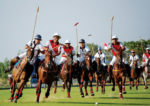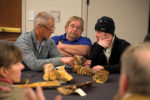Advertise Follow Us
Steve Kraus
Steve Kraus, CJF, is Cornell University’s head of farrier services and senior lecturer for large animal surgery. He has been a farrier for more than 45 years.
ARTICLES
Work, intensity, duration, terrain and horse are the five considerations farriers should consider when selecting footgear for a horse
Read More
How the Horse Shaped Horseshoes
From transportation to the show ring, the changing role of the horse and industry influenced the production of horseshoes
By Steve Kraus
posted on
September 13, 2020
| Posted in Business Practices, Education, Equipment, Shoeing, Products
Read More
Price Strategies for New and Reset Horseshoes
Analyze your business and clientele to choose the best practice
Read More
Chalklines Help Determine Trim
See how the golden ratio helps farrier Steve Kraus of Cornell University teach students how to develop their eye for trimming
Read More
From the AFJ Archives: April 2018
July/August 1983
By Steve Kraus
posted on
April 7, 2018
| Posted in Anatomy, Business Practices, Disciplines & Breeds, Education, Equipment, Forging, Shoeing
Read More
Keeping Polo Athletes Competing
The dos and don’ts of trimming and shoeing these hard working horses
By Steve Kraus
posted on
March 6, 2017
| Posted in Disciplines & Breeds, Education, Lamenesses, Shoeing
Read More
Is The Saddle The Problem?
Understanding general principles can help farriers confirm or eliminate causes of lameness
Read More
Treating Hoof Infections With Maggots
Following a consultation with a veterinarian, this farrier uses maggot therapy for tough case
Read More
Red Flags for Farriers
Are you Driving Proper Nails?
If you’re shoeing horses that are coming up lame, look for signs that your hammering is missing the mark
Read More
Top Articles
Current Issue
American Farriers Journal
American Farriers Journal is the “hands-on” magazine for professional farriers, equine veterinarians and horse care product and service buyers.
Regulation is Here & it’s Gaining Momentum
How Crooked Carriage Affects Equine Performance
Managing Low Palmar Angles in Horses
Current Issue
Special Report For Equine Veterinarians
American Farriers Journal is the “hands-on” magazine for professional farriers, equine veterinarians and horse care product and service buyers.
Must Read Free Eguides
Download these helpful knowledge building tools
- Caring for Your Horse During a Pandemic
- CBD Products Have Promise for Farriers, but Buyer Beware
- Sharpening Knives with a Buffer
- Winter Hoof Care
Videos
Farrier Education: Heartland Horseshoeing School
Farriery requires knowledge and skills to provide proper equine hoof care. In this series, sponsored by VICTORY, American Farriers Journal visits Heartland Horseshoeing School in Lamar, Mo. In this edition, Chris Gregory discussed his journey to becoming an educator, his focus in teaching farrier students and the state of farrier education.
Events
EMS (IR) and PPID: Diagnosis and Management (Part 1) Webinar
Date: 02/26/24
Location:
View Event
Top Directory Listings
Life Data Labs Inc
Life Data Labs Inc. is a dedicated product manufacturer committed to producing premium quality animal nutrition and health products through continuous product improvement and new product development. First-class ingredients, fresh products, consistent high quality and scientifically proven effectiveness are the principal features of Life Data Labs animal health products. And that's why they've produced the #1 recommended hoof supplement by farriers for 12 consecutive years.
Kawell USA
Kawell develops and produces copper alloy horseshoes and inserts, giving horses the care that they need to fight issues associated with white line disease, seedy toe and thrush.
SmartPak
From the feed room to the tack room, SmartPak offers innovative solutions to help riders take great care of their horses. SmartPak was founded in 1999 with the introduction of the patented SmartPak™ supplement feeding system. The revolutionary, daily dose SmartPaks are custom-made for your horse, individually labeled and sealed for freshness.















